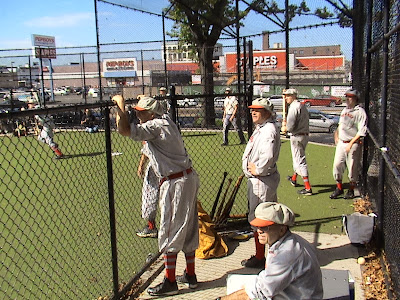Photo by Mark Granieri
The opening match got off to a less than stellar start when Hoboken tallied three times in the top of the first inning, but the Neshanock battled back, tallying five times in the bottom of the frame. The match turned into a back and forth offensive affair, unlike the low scoring matches of the past two weeks. Hoboken tied it at 8-8 in the top of the fourth, but Flemington answered with four runs in the bottom of the inning to go ahead 12-8. The Neshanock added two more in the bottom of the fifth and although Hoboken kept nibbling away at the lead, Flemington held on for a 17-13 victory.
Photo by Mark Granieri
Now back at .500, everything came down to the second game, a seven inning affair, like the first, played under 1864 rules. With a winning season in sight, the Neshanock were not to be denied and combined heavy hitting with outstanding defense to win going away by a 15-4 count. According to "Gaslight's" account, Chris "Lowball" Lowry, Ken "Tumbles" Mandel, Tom "Thumbs" Hoepfner, Dan "Sledge" Hammer, Jack "Doc" Kitson and Joe "Mick" Murray all made defensive plays of note. I'm sure "Gaslight" was his usual steady self behind the plate, he's just too modest to say so.
Photo by Mark Granieri
With the sweep, the Neshanock did indeed record an winning campaign in 2013 finishing at 24-23, reportedly the first winning season in about eight years. As important as the final record is, it also needs to be said that it was, once again, an enjoyable season - this was my fourth year as Neshanock scorekeeper and I've enjoyed the experience a great deal. Thanks to all of the Neshanock players, wives, girl friends and significant others who make each match so much fun. Special thanks also to Brad "Brooklyn" Shaw for his tireless efforts as club president, Chris "Low Ball" Lowry as captain and to Mark "Gaslight" Granieri for taking so many pictures over the course of the season. Thanks also to Sam "It aint' nothing until I say it is" Bernstein for working so hard to re-create the role of a 19th century umpire.
Photo by Mark Granieri
The last game of the 2013 vintage season marks the 158th consecutive year of New Jersey clubs playing base ball, or at least the New York game. The end of the vintage season led me to think a little about 1855 when two teams in Jersey City, five in Newark plus a few others in Hudson and Essex Counties introduced the "new" game to our state. My guess is these new clubs didn't think of it so much in terms of a season especially in Newark where each club played only a few games. Most likely it was a case of forming a club, playing some games until it was too cold to play more and/or other activities especially work intervened.
Photo by Mark Granieri
At some point, of course, they had to decide what they were going to do when warmer weather came around again. The most important decision was not so much whether they were going to play base ball, they could do that in a number of informal ways without making any major commitments. Rather the important decision was more about whether they wanted to continue to be part of a base ball club which involved more work than just getting together for an afternoon of hitting and fielding. Things like securing a ground, getting uniforms, arranging matches including transportation to away matches, not to mention the potentially controversial decisions about who made the first nine.
Photo by Mark Granieri
Photo by Mark Granieri
In one of those uncanny connections between today and the 1855 charter clubs, the issue of having enough players has faced a number of vintage clubs this year including the Neshanock. Saturday's opponent, the Hoboken Nine, only had six at the match, one of the fill-ins was from the New York Gothams which has had similar challenges. There's also been more than one occasion when Flemington was hard pressed to field a full nine. It's not a question of a lack of commitment, but rather issues of life changes, injuries, aging and other responsibilities that made fielding a full team more of a challenge this season. As a non-playing score keeper, my presence or absence doesn't impact having enough players, but I missed more matches this year than in the past and already know of a number of potential conflicts for 2014.
Photo by Ann Colduevill
While finding playing fields and losing players to other clubs was clearly a challenge to those 1855 clubs, my guess is that the clubs which continued in 1856 simply wanted to do it badly enough that they found ways to do so. We can't underestimate the importance of continual play by New Jersey clubs, especially the Newark and Newark Junior Clubs which stayed on until the Civil War years. If every New Jersey club had gone out of existence after one "season," it wouldn't say much about the popularity of the new game and couldn't have done anything to facilitate the game's growth. Fortunately that first group of New Jersey players worked things out. In a different way, it would be equally disappointing and sad, if any of today's vintage clubs went out of existence. My hope is that the Neshanock and other clubs facing similar challenges will follow the example of those first clubs so 2014 can be another fun year of vintage base ball.





























